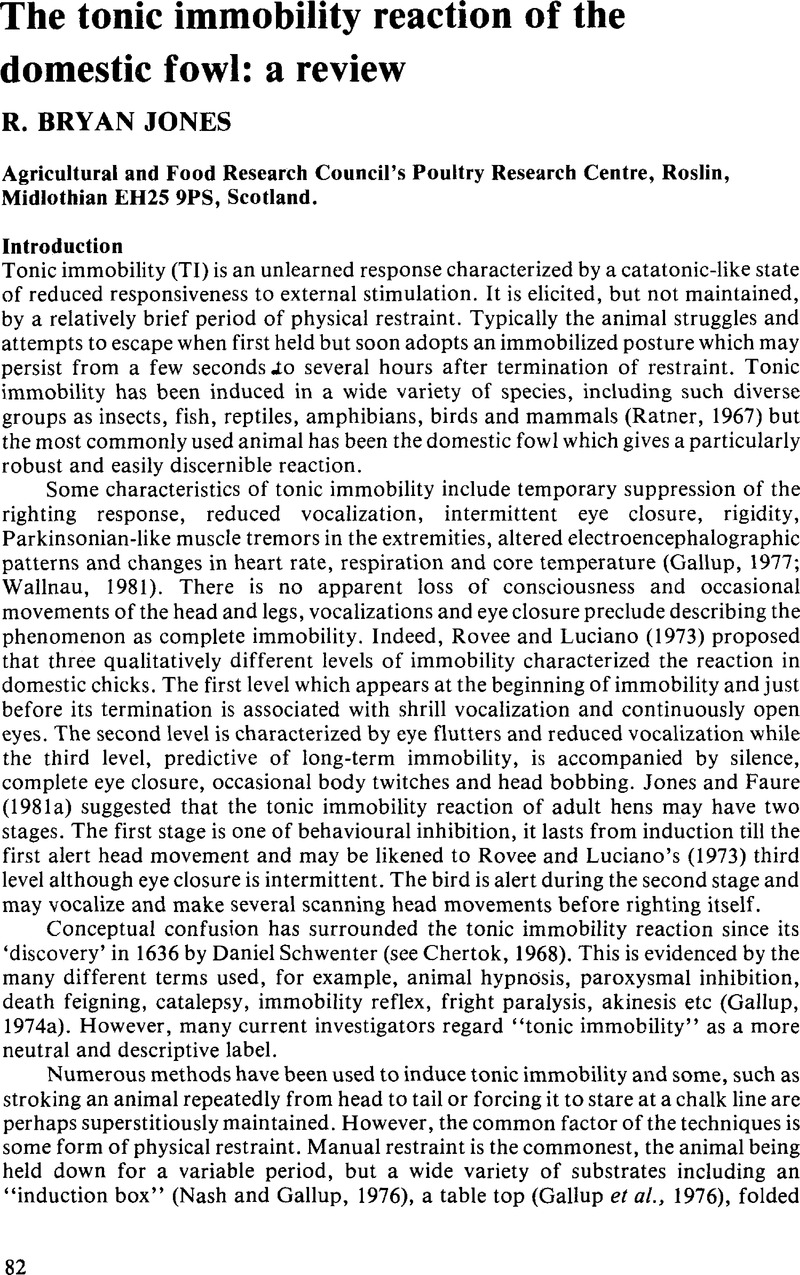Crossref Citations
This article has been cited by the following publications. This list is generated based on data provided by Crossref.
Glatz, P. C.
1987.
Effects of beak trimming and restraint on heart rate, food intake, body weight and egg production in hens.
British Poultry Science,
Vol. 28,
Issue. 4,
p.
601.
Jones, R. B.
1987.
Assessment of fear in adult laying hens: Correlational analysis of methods and measures.
British Poultry Science,
Vol. 28,
Issue. 2,
p.
319.
Jones, R.Bryan
Beuving, Gerard
and
Blokhuis, Harry J.
1988.
Tonic immobility and heterophil/lymphocyte responses of the domestic fowl to corticosterone infusion.
Physiology & Behavior,
Vol. 42,
Issue. 3,
p.
249.
Jones, R.Bryan
1988.
Repeatability of fear ranks among adult laying hens.
Applied Animal Behaviour Science,
Vol. 19,
Issue. 3-4,
p.
297.
Beuving, G.
Jones, R. B.
and
Blokhuis, H. J.
1989.
Adrenocortical and heterophil/lymphocyte responses to challenge in hens showing short or long tonic immobility reactions.
British Poultry Science,
Vol. 30,
Issue. 1,
p.
175.
Jones, R.Bryan
1989.
Experimenter visibility, spectacles and tonic immobility in the domestic fowl.
Applied Animal Behaviour Science,
Vol. 22,
Issue. 3-4,
p.
371.
Cashman, P. J.
Nicol, Christine J.
and
Jones, R. B.
1989.
Effects of transportation on the tonic immobility fear reactions of broilers.
British Poultry Science,
Vol. 30,
Issue. 2,
p.
211.
Gentle, Michael J.
Jones, R.Bryan
and
Woolley, Sharon C.
1989.
Physiological changes during tonic immobility in Gallus gallus var domesticus.
Physiology & Behavior,
Vol. 46,
Issue. 5,
p.
843.
Jones, R.Bryan
1989.
Chronic stressors, tonic immobility and leucocytic responses in the domestic fowl.
Physiology & Behavior,
Vol. 46,
Issue. 3,
p.
439.
Dornfeldt, K.
and
Bilo, D.
1990.
Effects of Intranasal Application of the Local Anaesthetic Xylocaine on Vestibulo-, Opto-Collic and Postural Reflexes of the Head, and on Tonic Immobility in Homing Pigeons: Implications for Experiments on Pigeon Homing.
Journal of Experimental Biology,
Vol. 149,
Issue. 1,
p.
95.
Nicol, C.J.
and
Scott, G.B.
1990.
Pre-slaughter handling and transport of broiler chickens.
Applied Animal Behaviour Science,
Vol. 28,
Issue. 1-2,
p.
57.
Knowles, T.G.
and
Broom, D.M.
1990.
The handling and transport of broilers and spent hens.
Applied Animal Behaviour Science,
Vol. 28,
Issue. 1-2,
p.
75.
MIELNIK, MARIA
CRAIG, J.V.
and
MILLIKEN, G.A.
1992.
Research Note: Beak Trimming and Holding Time Effects on Fearfulness of Pullets as Estimated by Tonic Immobility.
Poultry Science,
Vol. 71,
Issue. 2,
p.
391.
JONES, R.B.
SATTERLEE, D.G.
and
RYDER, F.H.
1992.
Research Note: Open-Field Behavior of Japanese Quail Chicks Genetically Selected for Low or High Plasma Corticosterone Response to Immobilization Stress.
Poultry Science,
Vol. 71,
Issue. 8,
p.
1403.
Bryan Jones, R.
and
Waddington, David
1992.
Modification of fear in domestic chicks, Gallus gallus domesticus, via regular handling and early environmental enrichment.
Animal Behaviour,
Vol. 43,
Issue. 6,
p.
1021.
Kostal, Lubor
Savory, C. John
and
Hughes, Barry O.
1992.
Diurnal and individual variation in behaviour of restricted-fed broiler breeders.
Applied Animal Behaviour Science,
Vol. 32,
Issue. 4,
p.
361.
Jones, R. Bryan
and
Andrew, Richard J.
1992.
Responses of adult domestic cocks and capons to novel and alarming stimuli.
Behavioural Processes,
Vol. 26,
Issue. 2-3,
p.
189.
Scott, G B
and
Moran, P
1992.
Behavioural Responses of Laying Hens to Carriage on Horizontal and Inclined Conveyors.
Animal Welfare,
Vol. 1,
Issue. 4,
p.
269.
Jones, R. Bryan
1992.
The nature of handling immediately prior to test affects tonic immobility fear reactions in laying hens and broilers.
Applied Animal Behaviour Science,
Vol. 34,
Issue. 3,
p.
247.
Sherwin, C.M.
Kestin, S.C.
Nicol, C.J.
Knowles, T.G.
Brown, S.N.
Reed, H.J.
and
Warriss, P.D.
1993.
Variation in behavioural indices of fearfulness and fatigue in transported broilers.
British Veterinary Journal,
Vol. 149,
Issue. 6,
p.
571.



